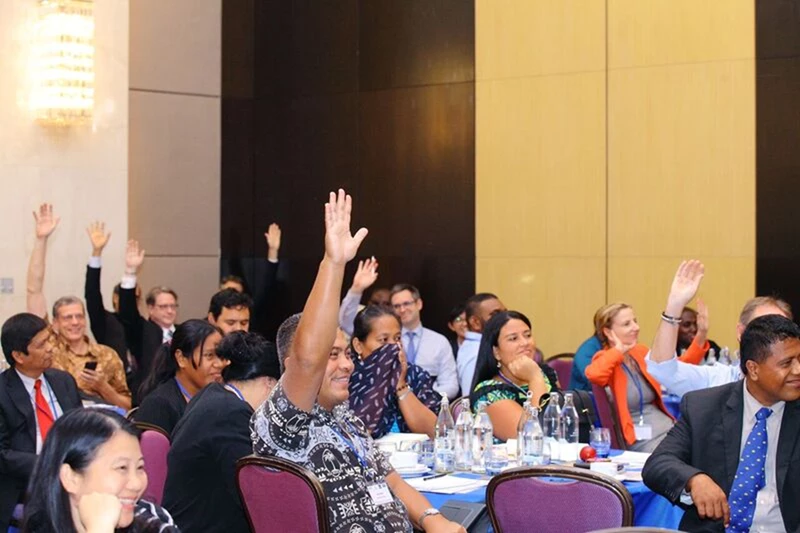The East Asia and Pacific region is vital to global pandemic preparedness. The region has been the epicenter of emerging and re-emerging infectious diseases. China and Southeast Asia alone accounted for approximately 90 percent of SARS cases and two-thirds of the human cases of avian influenza in the world. These outbreaks are driven by several socio-economic, demographic, environmental, and ecological factors, including close contact between humans and animals, encroachment with wildlife, high population density, rapid urbanization, high growth rates, and climate change.
Recognizing the threats, several countries in the region have made tremendous efforts to tackle emerging infectious diseases; however, many challenges remain in ensuring adequate and efficient sustainable financing and systems for health security. Thus, it is essential that all involved in building sustainable financing and resilient systems for health security take time to forge clear directions and explore new avenues for realising this important work.

Such was the purpose of the side meeting, “Building Sustainable Financing and Resilient Systems for Health Security,” at the Prince Mahidol Award Conference (PMAC) in Bangkok earlier this year.
The various sessions over the two-day meeting included engaging presentations and lively discussions among participants from the region. They helped think through the best approaches to building sustainable heath security in the region, namely:
- making an economic case for investment in health security
- strengthening human health and animal health systems, and the links between the two
- engaging the private sector in the health security dialogue, and
- exploring new forms of financing such as pandemic insurance.
Dr Supamit Chunsuthiwat, an advisor to Thailand’s Department of Disease Control, hit the point home when he related to the meeting how the Ministry of Public Health got the government to approve its multi-million dollar influenza vaccine production facility.
In 2004, Thailand was hit by the H5N1 avian influenza (birdflu) which threatened the huge poultry industry in Thailand. Millions of chickens were culled and public confidence in government handling of the crisis was low. “What drove the government to make the investment was the economic impact that was also affecting political stability,” Dr Supamit said. “We just had to produce good evidence to support this argument.”
Kenneth Mugambe, budget director at Uganda’s Ministry of Finance, agreed that the new approach is needed because finance people are not readily sold on health security. “I don’t know what the IHR (international health regulations) and JEE (joint external evaluation) are. It’s up to health people to use them to make the case (for budget spending),” Kenneth said.
World Bank advisor Mukesh Chawla also captured audience attention during the financing response session by suggesting the use of innovative financing, such as the Pandemic Emergency Financing Facility (PEF), a quick-disbursing financing mechanism that provides a surge of funds to enable a rapid and effective response to a large-scale disease outbreak. He pointed out that it took the health community five months to mobilize funds to handle the Ebola outbreak, which proved to be too late to contain the spread of the deadly disease.
“You can insure anything so why not a pandemic?” Mukesh said.
Many speakers also observed that since pandemic preparedness must be a whole of society response, the glaring absence of the private sector from the health security dialogue is something to be quickly redressed.
Eduardo Banzon, the Asian Development Bank’s Principal Health Specialist, argued the private sector would be a huge boon in mobilizing domestic resources for pandemic preparedness. However, a lot more information and details must be prepared to show that the issue is important for their business continuity.
“They would want to know what they are paying for,” Eduardo said.
Stella Chungong, Chief of the health emergencies program at WHO, also spoke of the value of sharing experiences, the importance of the one health approach and multisectoral coordination to accelerate global health security (GHS).
“For this, partners need to align their support with national priorities, and the countries need to take ownership to drive these efforts,” Stella said.
Casey Barton Behravesh, Director of the US CDC’s One Health Office, elaborated on the One Health approach saying the concept of global health security must integrate human and animal health, as well as environmental sustainability. This will ensure not only the achievement of GHS but also Universal Health Coverage and sustainable development.
“The foundation for addressing these factors is coordination communication, collaboration and working together to best maximize limited resources to address these health threats,” Casey stressed.
A much-awaited session of the PMAC side meeting was of course the one on the Health Security Financing Assessment (HSFA) piloting in Vietnam. The study uses assessment tools to track the source and flow of funds as well as institutional mechanisms covering 19 technical areas specified under the Joint External Evaluation (JEE) tool and will be completed in the middle of 2018. Vietnam team member Nguyen Khanh Phuong reported that the HSFA is proving to be a valuable tool in identifying constraints in health security financing and gauging the strengths and weaknesses of coordination and implementation mechanisms.
“The lessons learnt will benefit other countries in the region where the HSFA tools will also be used to gauge their health security financing needs,” Nguyen Khanh Phuong said.
The PMAC Side Meeting was truly fruitful and our thanks go to all of the energetic participants whose number did not dwindle throughout the long and tightly packed schedule. Your insight, experience and dedication have made invaluable contribution to our endeavour to ensure health and economic security for the region.



Join the Conversation